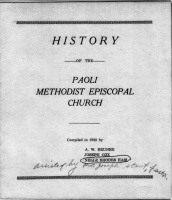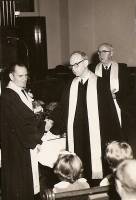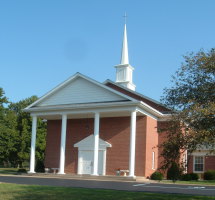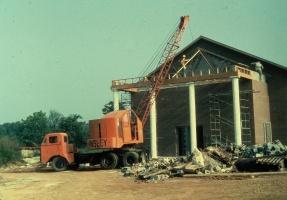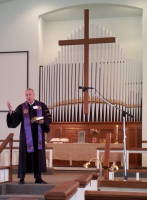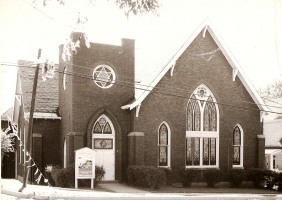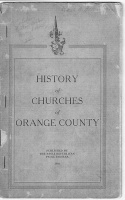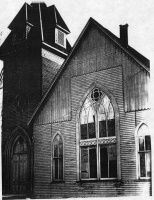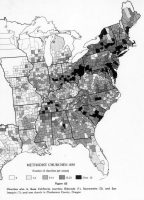History of the Paoli Methodist Episcopal Church

In 1932, church members A. W. Bruner, Joseph Cox and Nelles Rhodes Ham, with the assistance of the current pastor, Rev. Joseph Stout, wrote the History of the Paoli Methodist Episcopal Church .
We have scanned the booklet and converted it to a PDF file. Click here or on the image at right to open this scan of the original document, or right-click to save it to your system for later reading. Given the size of the document (13.5 MB), unless you have a fast Internet connection you may prefer to save it to your local system so you only have to download it once.
Or, you can simply read the text below.
HISTORY |
||
— OF THE — |
||
PAOLI
|
||
—— |
||
Compiled in 1932 by
|
EARLY CHURCH HISTORY
The country west of the Allegheny mountains was called the Western Country. The first Conference organized in this territory was called the Kentucky Conference. In 1801 the first Circuit was formed within Indiana territory and called the Silver Creek Circuit. Moses Ashworth was the preacher in charge. The Circuit extended along the Ohio River as far west as Mt. Vernon and east to Madison. The territory included what was known as Blue River Settlement. Later this settlement and the country north known as Orange County was called Blue River Circuit.
The "Circuit Plan" of the early circuit rider has been lost, but it is known that there were several preaching places in and about Paoli, which were not only served by the ministers appointed to the circuits, but the Presiding Elders and many noted preachers of the period, were heard by the people called Methodists.
In 1800 the Kentucky Conference was designated as the Western Conference, of which Southern Indiana was a part.
In 1816, the Southwestern Section of Indiana was included in the Missouri Conference.
The General Conference of 1824 divided the Missouri and Ohio Conferences and placed Illinois and Indiana in the Illinois Conference.
In 1825, the Illinois Conference met at Charlestown Indiana, and at this Conference, Paoli was made the head of a Circuit and John Miller was appointed to the church, succeeding Edward Smith, who had served the church during the year 1824. John Miller was succeeded in 1826 by H. W. Smith as Senior preacher and Smith L. Robinson as Junior preacher At this time Paoli was in the Charleston District and James Armstrong was the Presiding Elder. In the year 1827, William Moore was the Senior preacher and James McLean the Junior preacher.
In 1832 the Illinois Conference was divided and the Indiana Conference was organized at New Albany, Indiana.
Methodism began to take root in Indiana in the early part of the last century, and circuit riders, crossing the Ohio river from Kentucky into Indiana, made Paoli one of their points as early as 1809 or '10; but it was not until 1818 that a church organization was perfected.
The first Methodist church in Indiana was built in Clark's Grant, upon ground now a part of Clark county, and the log cabin structure is still preserved and sheltered as a shrine at Charlestown. From this point the church widened its scope and reached out into other southern Indiana counties, including our own Orange County.
The old stone courthouse, erected 1818 on the northwest corner of the public square, was used as a place of worship until the erection of the first church in 1838.
Prior to the time of the erection of the old stone courthouse, meetings were held in the homes of the early settlers, who heard the Gospel preached by the circuit riders, those physical and spiritual giants of the wilderness, among whom were many great men of God. They were called circuit riders because of their numerous appointments and their mode of travel, which was horseback. They traveled far and near, carrying in their saddlebags the first books that found their way into remote cabins.
In the old city cemetery, where rest the bodies of many devout pioneers, may be found a plain stone monument inscribed with the name of Elder William Beauchamp, one of the truly great early ministers making Paoli one of his points. He was one of the early Presiding Elders of the Missouri Conference. He died in Paoli in 1824. Presiding Elder Beauchamp had filled pulpits in New York, Boston, Pittsburg, and other large cities. He was sometimes styled "The Demosthenes of the West," because of his splendid voice and ability as an orator. He was at one time editor of the Christian Monitor, the only Methodist paper published in that day. Presiding Elder Beauchamp lacked but two votes of being elected Bishop when he was a delegate to the General Conference at Baltimore in 1823.
Such was the character and high standing of the early ministers who preached the word in Paoli and blazed the trail of Methodism into Southern Indiana.
In 1824 Rev. Edward Smith was on the Paoli circuit, his ministry covering a wide territory. Rev. John Miller, following in 1825, brought the word to 422 members on his circuit. The following year, 1826, W. H. Smith and Smith L. Robinsan were the ministers and James Armstrong, the presiding Elder. They were succeeded in 1827 by William Moore and James McLean, Rev. Armstrong continuing as Presiding Elder.
Of the early worshippers in Paoli, there, were the Jacksons, Kearbys, Osbornes, Moores, Giffords, and Throops; the McVey, Millis, Kiger, Stucker, Wilson, Collins, Coffin, Meacham, Chapman, Campbell, and Craig families were also among the early members, whose descendants are scattered, but some still reside in this community. They heard such men expound the Gospel as John Strange, camp meeting evangelist, Peter Cartwright, and Bishop R. R. Roberts, profound men of God, who laid the foundation of Methodism in Southern Indiana. They endured untold hardships and suffered great privations that the church might be established and that the pioneers, struggling for a meager existence, might not forget God.
John Strange was sometimes called the "prince of circuit riders," who once said that his alma mater was "Brush College."
Of Bishop Roberts, 'tis said that, like Paul, who was a tent maker, he sometimes found it necessary to take up some other line of work as a sideline in order to provide for the body as well as the soul; altho the ministry was always the primary work of his life, Bishop Roberts was a craftsman, his efficiency in this line being demonstrated in a set of dining room chairs made by him in pioneer times and now owned by A. W. Bruner, this city, and greatly cherished.
Of the physical build of the circuit riders filling points along the Paoli circuit, some are said to have been mighty in both height and breadth.
One of these giants was six feet, four inches tall, and 'tis said of him, on one occasion, that he was obliged to remove one of the overhead boards in the rude building being used as a church in order to stand up while he preached. Being of that sturdy type that would not be daunted by such minor handicaps, he delivered his message from the attic with no lack of eloquence. Another one of the pioneer ministers, preaching in this section, is said to have weighed 280 pounds, and perhaps needed all his giant strength to combat the enemies of the forest and to surmount all the obstacles that often confronted the circuit rider.
The Charlestown District extended from the Ohio river as far north as the present city of Logansport. In Orange county the circuit included Paoli, French Lick, Orangeville, Bond's Chapel, Stampers Creek (Kearby's), the Island, and Moore's Ridge. Bishop Asbury, one of the great pioneer ministers, is said to have made a circuit in the work of the Master that would have measured twelve times around the earth.
Among the early pastors of the Paoli circuit was Rev. Francis Walker, father of Dr. J. M. Walker, who was assign to this circuit in November, 1861, upon the death of the former pastor, Rev. Julius King, who died of typhoid fever soon after reaching his charge here. Dr. Walker says that his father had seven points on the circuit at that time, including, besides Paoli, Nelson's Chapel, Kearby's, Mt. Gilead, Hill's, Prospect, and Chambersburg. Paoli was in the Bedford district at that time and the Presiding Elder was Rev. Hayden Hayes.
Among the early worshippers the name of John Throop Sr. stands out prominently in Paoli Methodism. Mr. Throop was one of the founders of the church, and his home, the present Throop homestead, was the stopping place of the circuit riders that supplied the Paoli church. John Throop Sr., who was the father of Miss Sarah Throop, this city, and of the late Miss Jane Throop and Joseph P. Throop, all devout workers of the church, instituted the Methodist Sunday School in Paoli and for many years he was it's worthy superintendent.
Charlestown was the first, and only district in the state in the beginning. Paoli was in the Charlestown district. Some years later four other districts were formed, including, besides Charlestown, Wabash, Crawfordsville, Madison and Indianapolis districts. In 1832, William Shanks was Presiding Elder of this district, and Paoli was served by Rev. Henry S. Talbot, who was engaged in the ministry for 42 years. He also served the following year with Rev. Jesse Harbin as supply. In 1835, Rev. Isaac McElroy was Presiding Elder, J. S. Bayless, pastor, and Elijah Whitten, supply. Rev. C. W. Ruter was Presiding Elder in 1836, James T. Robe, pastor, Jacob M. Stallard was pastor in 1837, Rev. Ruter continuing as Presiding Elder. Rev. Ruter served two years as Presiding Elder and Rev. Stallard continued as pastor in 1838, the year the first church was built. James Crawford was supply that year.
In 1839 the church was changed from the Charlestown district to the Bloomington district, with Rev. H. S. Talbot as Presiding Elder; William McGinnis, pastor; John Talbot, supply. In 1840, Rev. John Miller was Presiding Elder, Draper Chipman, pastor; Morris Benton, supply. In 1841, Phillip May was pastor, M. Mahan, supply. In 1842, the church was transferred from the Bloomington to the Evansville district, Rev. H. S. Talbot, Presiding Elder, Peter R. Guthrie, pastor. In 1843, Rev. John Kearns was Presiding Elder, P. R, Guthrie, pastor, and George R. Jocelyn, supply. It will be noted that a change in minister was made practically every year, a fact, doubtless, due to the hardships of the circuit rather than to dissatisfaction on the part of the church with the services provided. It seems probable that some of them sought to be assigned to other fields where the trails were less rugged than the old Buffalo trail of this section.
The building of the first house of worship must have been deemed a great achievement by the early Methodists. They had been organized since soon after the town of Paoli was laid out and settled, and, no doubt, they longed to have a House of God, a place af their own in which to work together in Christian fellowship. To accomplish this noble aim, however, they had the hearty cooperation of another denomination, the Presbyterians, and others interested in the erection of the church. The structure was built by labor that was donated by members or other interested parties; the lumber was also donated by both Methodists and Presbyterians, with an agreement that both should use the church as a house of worship, when completed, occupying it alternately. In 1840 the Methodists became sole owners of the building.
Some af the early trustees of the church were John Throop, G. G. Smith, Henry Shirley, Lewis F. Wilson, William Higgins, David Osborne, Henry Millis, and Edward Kearby.
It will be interesting here to note the location and style of architecture of the church. It was built on the site where the Methodist parsonage now stands, on East Main St. The site was purchased of Thomas Pitts for the sum of $50. The building had a great many windows, small, and in rows, one above the other. It had two front doors, one leading to the men's and one to the women's side, for the Methodists of that day had inherited of the early Friends the custom of separating the men and women at church. There were two other doors one on the west, used only for ventilation, and another on the east leading to the parsonage, which was north-east of the church.
On the south side was erected the belfry, in which the bell hung in full view of the public. Its deep, solemn tones reverberated thru the house as the worshippers assembled or were heard abroad thru the town, calling men and women to come into the House of the Lord.
The church was a frame structure, its exterior painted a dull brown, as it is pictured in the memory of those remembering when it had fallen to decay. It may have been weatherbeaten. Within the church was a partition, one side of which was often referred to as the Presbyterian side. Above this partition, in the rear, was the first choir, which filled two benches. The choir was led by Mrs. T. B. Jackson, an aunt of Miss Lizzie McVey and E. W. McVey this city. Among the singers in the old choir were Miss Sena Cox, a former teacher in the Paoli schools, vho sang alto, and Mrs. Benjamin D. Stinson, who sang soprano. The first musical instrument ever used in the old church was a melodeon, which was loaned to the church by the late Judge Simpson. It was a great innovation, but the propriety of its use may have been in question among some of the pioneer worshippers.
Over the front entrance of the church was a gallery, which looked down on the congregation below and was often filled during the revival season. Above it stretched the wide, high ceiling, which reached 25 feet from the floor. Near the side entrances on the east and west were the "Amen" corners, the accustomed pews of the staid old men of God, the faithfuls and backbone of the church. But the one on the east, so it is said, was often used by the young people of the church, and it was not uncommon on Sunday evenings to see some young swain escorting his best girl into one of the Amen pews on the east side. It is related that, on one occasion, a handsome young couple occupied this particular section when the fair lady was claimed by Morpheus and slept throughout the minister's fourthly, fifthly and lastly, much to the chagrin of her escort who listened with dignified mien thru out the long discourse.
The pulpit, behind which stood the minister, as he brought the message, was a mottled, red-paneled affair, almost concealing the pastor if he happened to be small of stature. The benches, upon which sat the congregation as they gathered for worship, were of the high straight-backed type used in that day. The altar was in front of the rostrum, round which was a railing, and 'twas at this altar that 169 converts were claimed for Christ under the ministry of Rev. J. A. Scammahorn, who conducted one of the greatest revivals ever held in Paoli. There were about 75 accessions to the church and the pastor sprinkled 60 persons at one baptismal service.
During this great spiritual awakening in the church, there were many prominent business and professional men converted, men and women of every walk of life, young people, children, middle aged, old folks. The effect of the revival was felt in the public schools, which were under the supervision of Prof. W. P. Pinkham, prominent educator and minister of the Friends church who afterward accepted a chair in Earlham College. Mr. Pinkham, a man of strong character and great foresight, dismissed the schools in order that students might attend the revival meetings and become stronger minded spiritually. This step was a factor in bringing many young people into the fold. The revival also reached out into other churches and strengthened every denomination in town.
Another source of great spiritual awakening in the early church was the Methodist camp meeting. In 1841 a piece of land south of town, located on the present Omer Farlow farm, was selected as a camp meeting ground and was thus used for 4 or 6 years at certain intervals during the year. The camp meetings sometimes lasted for a period of three or four weeks and were attended by throngs of Methodists, whole families coming to remain during the series, the food being mostly donated by farmers and others of this and surrounding communities. The women prepared the meals over the open fire while the minister exhorted. Among the evangelists preaching for the camp meetings here were some with remarkable lung power, whose voices could be heard up and down Lick Creek a long distance.
One of the noted evangelists conducting meetings here was Lorenzo Dow, who achieved great success in the ministry. He is said to have had long flowing hair, and Mrs. Dow, who traveled with him, had a short shingle, in contrast so striking as to be remarked about by the members worshipping in God's first temples.
A song leader often accompanied the evangelist on camp meeting tours and led the assemblage in singing the old hymns, which were frequently interspersed with shoutings. These old fashioned camp meetings were spiritual feasts and the spirit moved men in such a way that they cast aside all reserve and false pride. They were not ashamed to acknowledge their Lord.
The old church on East Main served the Methodists of Paoli from 1839 until 1881, when a new church, the present one, was completed. The membership had outgrown the old structure, which was no longer adequate in size or arrangement for the growing needs of the church. The contract for building the new church on West Main St. was let May 6, 1880, to Mr. Lemmon, of Mitchell, for the sum of $2,175, the building site having been purchased for $250. The cornerstone was laid August 18, Rev. J. H. Ketchum officiating, and the following summer, 1881, the dedication took place, Rev. J. S. Woods, D. D., of New Albany, preaching the morning sermon. The sacramental service was in charge of Rev. E. P. F. Wells in the afternoon, and Rev. J. A. Scammahorn delivered the evening sermon. Present at the dedication of the new church were only two who had attended the dedication of the first church. They were Judge A. J. Simpson and Samuel Lingle, father of the late B. M. Lingle.
The building committee in charge of plans for building the new church was composed of William F. Osborne, A. J. Rhodes, and H. E. Wells.
Rev. M. S. Heavenridge was pastor at the time of the dedication. Pastors of the church from that day down to the present include a long line of zealous workers for the Lord. Beginning back in 1875, which closed the ministry here of Rev. Scammahorn, pastors of the church down to the present are as follows: Revds. Eller (75-76); Webb (76-79); Heavenridge (79-80); Wells (80-82); Miller (82-83); Boring (83-85); Tansy (85-87); Dorsey (87-89); Rader (89-94); Baker (94-97); Selby (91-99) F. L. Priest (1899-1900); McCallister (1900-1902); Hoon (1902-1903); Baldridge (1903-1905); Breeden (1905-1906); McFall (1906-1910); Raff (1910-1912); Haley (1912-1914); St. Clair (1914-1915); Alexsander (1915-1917); Asher (1917-1920); Dalrymple (1920-1925); Bassett (1925-1928); LaHue (1928-1929); Murr (1929-1930); Brittingham (1930-1932); Rev Joseph L. Stout is the present pastor.
Here we shall refer to some of the loyal workers of the church during the pastorate of Rev. J. W. McFall and prior to that time. They were the men and women who were the power in the church, whose prayers went up daily and whose voices could always be heard in the house of the Lord. Among them were the following: Mr. and Mrs. William F. Harrison, parents of Charles Harrison, Mr. and Mrs. Christian Pro, Mrs. Susan Kurrie, Mr. and Mrs. Summers, Mr. and Mrs. W. M. Baggerly, Mrs. Miller, Mrs. Lettie Cole, Mrs Caroline Swallow, Mr. and Mrs. Jonathan McVey, Mr. and Mrs. Alfred McVey, Mr. and Mrs. W. E. Hoppee, Mrs. Anne Wood, Mr. and Mrs. Allen Jackson, Mrs. Mary Ireland, Mr. and Mrs. M. F. Ham, and Mr. and Mrs. A. J. Rhodes. This list named comprised the old people of that day.
In 1923, during the pastorate of Rev. George Dalrymple, the church underwent an improvement program. A new addition was built. including a modern gymnasium, which is now deemed a very necessary part of a modern church as a recreational center for the young people and for the general use of the church for entertainments and social affairs. In the basement of the new addition is located the dining room and kitchen, the church parlor and class rooms for use of the Sunday School.
Many changes were also made in the church proper. The exterior was brick veneered and made more attractive. New memorial windows were installed, these windows having been financed by relatives of deceased members and by Sunday School classes and other departments of the church. The interior of the church was re-decorated and made into a most beautiful house of worship. Altho it incurred a financial obligation that has proven somewhat burdensome during the present financial crisis, it will eventually be paid in full and will always be a source of pride among parishoners. A pipe organ was installed during the pastorate of Rev. H. D. Bassett.
The remodeled church was dedicated October 14, 1923, Dr. J. W. McFall, a former pastor, delivering the morning and evening sermons and Dr. M. A. Farr, the dedicatory sermon in the afternoon.
The Ladies Aid, the Women's Foreign Missionary Society, and the Epworth League, all great factors in the growth and development of the church, were each organized during the pastorate of Rev. W. S. Rader. The Epworth League, which has proven such a great force among the young people, was instituted in 1889, and was among the first chapters to be organized in the state. The other two organizations mentioned were organized in the early nineties. Mrs. Christian Pro was first president of the Ladies Aid, which was organized at the home of Mrs. Jacob Snider, a charter member, who is also a charter member of the Woman's Foreign Missionary Society, organized the same year at Mrs. W. M. Baggerly's millinery shop on the south west corner of the public square. Mrs. Baggerly was its first president. Besides Mrs. Snider, Miss Sarah Throop is a surviving charter member.
The Ladies Aid has always been a source of financial aid to the church, as its name implies, and is still functioning in the same efficient manner, always ready to help meet any emergency and unselfishly devoted to the interests of the church. Mrs. J. F. Whitmire is the present president, Mrs. Z. I. Moore is the present president of the Women's Foreign Missionary Society, which has always prospered, contributing to the evangelism of the world and also helping to strengthen the church at home.
We can not close this history of Paoli Methodism without paying a tribute to Rev. J. W. McCullough, who has resided in Paoli for many years and has been such an asset to the church. Altho retired from the ministry, he has served as supply on the Paoli charge, and is always prepared and ready to expound the scriptures and to serve the Master in whatever capacity he is called. Working in christian fellowship with all of the pastors, his has been a noble work and without him the church could not have attained the progress it has made in recent years,
Going back over the years and reviewing the history of Paoli Methodism, we are proud to note the long line of noble servants of God. We would like to pay last tribute to the early ministers, the old circuit riders, who blazed the trail. The incessant toil, the constant hardships, the ever-present dangers from floods, hostile Indians and savage wild beasts, endured by these pioneer Methodist ministers, was only surpassed by their bravery, their steadfastness, their courage and enthusiasm, their consecration and their Godliness. They were the Apostle Pauls of our early history and the world was their parish.
| List of the Paoli Pastors and Presiding Elders | |||
| Year | Pastor | District | Presiding Elder |
| 1832 | HENRY S. TALBOTT | Charleston | William Shanks |
| 1833 |
HENRY S. TALBOTT JESSIE HARBIN |
Charleston | William Shanks |
| 1834 |
D. STUCKER H. S. TALBOTT |
Charleston | William Shanks |
| 1835 | E. WHITTEN | Charleston | C. W. Ruter |
| 1836 | JAMES ROBE | Charleston | C. W. Ruter |
| 1837 | JACOB STALLARD | Charleston | C. W. Ruter |
| 1838 |
JACOB STALLARD JAMES CRAWFORD |
Charleston | C. W. Ruter |
| 1839 |
WILLIAM McGINNIS JOHN TALBOT |
Bloomington | H. S. Talbot |
| 1840 |
DRAPER CHIPMAN MORRIS BENTON |
Bloomington | John Miller |
| 1841 |
PHILIP MAY M. MAHAN |
Bloomington | John Miller |
| 1842 | PETER GUTHRIE | Evansville | H. S. Talbot |
| 1843 |
PETER GUTHRIE GEORGE B. JOCELYN |
Evansville | H. S. Talbot |
| 1844 | PETER GUTHRIE | ||
| 1845 | PETER GUTHRIE | ||
| 1846 | REV. KEMP | ||
| 1847 | REV. BELL | ||
| 1848 | H. O. CHAPMAN | ||
| 1849 | JAMES McCAW | Vincennes | Elijah Whitten |
| 1850 | WILLIAM V. DANNULL | Paoli | W. C. Smith |
| 1851 | WILLIAM V. DANNULL | Paoli | W. C. Smith |
| 1852 | JOHN W. POWELL | Orleans | W. C. Smith |
| 1853 | JOHN W. POWELL | Orleans | W. C. Smith |
| 1854 | JOHN W. POWELL | Bloomington | H. Hays |
| 1855 | L. M. HANCOCK | Bloomington | H. Hays |
| 1856 | L. M. HANCOCK | Bloomington | H. Hays |
| 1857 | J. C. KING | Bloomington | H. Hays |
| FRANCIS WALKER | Paoli | J. W. Julian | |
| 1858 | E. E. ROSE | Paoli | J. W. Julian |
| 1859 | S. LAYTON | Paoli | J. W. Julian |
| 1860 | W. H. JACKSON | Paoli | J. W. Julian |
| 1861 | W. H. JACKSON | ||
| 1862 | W. F. HARNED | Mitchell | I. N. Thompson |
| 1863 | W. F. HARNED | Mitchell | I. N. Thompson |
| 1864 | W. H. CORNELIUS | Mitchell | I. N. Thompson |
| 1865 | H. O. CHAPMAN | Mitchell | I. N. Thompson |
| 1866 | H. O. CHAPMAN | ||
| 1867 | D. SWARTZ | Mitchell | D. McIntyre |
| 1868 | L. JONES | Mitchell | John Walls |
| 1869 | L. JONES | Mitchell | John Walls |
| 1870 | G. W. TELLE | Mitchell | John Walls |
| 1871 | G. W. TELLE | Mitchell | John Kiger |
| 1872 | J. A. SCAMMAHORN | Mitchell | F. A. Hutcherson |
| 1876 | W. W. WEBB | Mitchell | F. A. Hutcherson |
| 1877 | W. W. WEBB | Mitchell | F. A. Hutcherson |
| 1878 | W. W. WEBB | Mitchell | F. A. Hutcherson |
| 1879 | ELI F. P. WALLS | Mitchell | F. A. Hutcherson |
| 1880 | ELI F. P. WALLS | Mitchell | John Walls |
| 1881 | M. S. HEAVENRIDGE | Mitchell | John Walls |
| 1882 | JOHN V. R. MILLER | New Albany | John Kiger |
| 1883 | N. E. BORING | New Albany | John Ketchum |
| 1884 | N. E. BORING | New Albany | John Ketchum |
| 1885 | JOHN TANSY | New Albany | John Ketchum |
| 1886 | JOHN TANSY | New Albany | John H. Ketcham |
| 1887 | SAMUEL O. DORSEY | New Albany | Allen R. Julian |
| 1888 | SAMUEL O. DORSEY | New Albany | Allen R. Julian |
| 1889 | WALTER S. RADER | New Albany | J. M. Baxter |
| 1890 | WALTER S. RADER | New Albany | J. M. Baxter |
| 1891 | WALTER S. RADER | New Albany | J. M. Baxter |
| 1892 | WALTER S. RADER | Bloomington | W. M. Zaring |
| 1893 | WALTER S. RADER | Bloomington | T. H. Willis |
| 1894 | J. W. BAKER | Bloomington | T. H. Willis |
| 1895 | J. W. BAKER | Bloomington | T. H. Willis |
| 1896 | ZACHARIAH SELBY | Bloomington | T. H. Willis |
| 1897 | ZACHARIAH SELBY | New Albany | J. E. Steele |
| 1898 | F. L. PRIEST | New Albany | J. E. Steele |
| 1899 | F. L. PRIEST | New Albany | J. E. Steele |
| 1900 | W. S. McALLISTER | New Albany | John Poucher |
| 1901 | W. S. McALLISTER | New Albany | John Poucher |
| 1902 | F. T. HOON | New Albany | John Poucher |
| 1903 | H. W. BALDRIDGE | New Albany | John Poucher |
| 1904 | H. W. BALDRIDGE | New Albany | John Poucher |
| 1905 | J. A. BREEDEN | New Albany | John Poucher |
| 1906 | J. W. McFALL | New Albany | John Poucher |
| District Superintendent | |||
| 1907 | J. W. McFALL | New Albany | W. M. Whitsitt |
| 1908 | J. W. McFALL | New Albany | W. M. Whitsitt |
| 1909 | J. W. McFALL | New Albany | W. M. Whitsitt |
| 1910 | R. W. RAFF | New Albany | W. M. Whitsitt |
| 1911 | R. W. RAFF | New Albany | W. M. Whitsitt |
| 1912 | O. E. HALEY | New Albany | W. M. Whitsitt |
| 1913 | O. E. HALEY | New Albany | J. M. Walker |
| 1914 | ELMER St. CLAIR | New Albany | J. M. Walker |
| 1915 | W. L. ALEXANDER | New Albany | J. M. Walker |
| 1916 | W. L. ALEXANDER | New Albany | J. M. Walker |
| 1917 | JOHN ASHER | New Albany | J. M. Walker |
| 1918 | JOHN ASHER | New Albany | M. A. Farr |
| 1919 | JOHN ASHER | New Albany | M. A. Farr |
| 1920 | GEORGE DALRYMPLE | New Albany | M. A. Farr |
| 1921 | GEORGE DALRYMPLE | New Albany | M. A. Farr |
| 1922 | GEORGE DALRYMPLE | New Albany | M. A. Farr |
| 1923 | GEORGE DALRYMPLE | New Albany | M. A. Farr |
| 1924 | GEORGE DALRYMPLE | New Albany | M. A. Farr |
| 1925 | H. D. BASSETT | New Albany | J. Edward Murr |
| 1926 | H. D. BASSETT | New Albany | J. Edward Murr |
| 1927 | H. D. BASSETT | New Albany | J. Edward Murr |
| 1928 | R. O. LAHUE | New Albany | J. Edward Murr |
| 1929 | L. C. MURR | New Albany | E. Robb Zaring |
| 1930 | M. BITTINGHAM | New Albany | E. Robb Zaring |
| 1931 | M. BITTINGHAM | New Albany | E. Robb Zaring |
| 1932 | JOSEPH L. STOUT | New Albany | E. Robb Zaring |
Below this is hand-written an incomplete continuation of this table:
Rev. Theron Castleman
1939
'36—
["1939" written and crossed out, "'36" added]
Rev. D. M. Boyd
Rev Clarence Stout
Rev James Radcliff 1946/7
["194" followed by superimposed "6" and "7"]
Rev Everett Wright 1949—52
Rev. Robert Rogers 1952—
Rev. Hubert Hoke
Rev. James V. Smith 1961—64
Richard Gillum 64—69
Rev Robert Allred 69—72
Eldon Brown 72—78
Dale Smith 78—80
Dr. Thomas Brooks 80—83
Jerry LeBrun 83—
Ken Wells
Howard Allen
Richard Russell
Jan Akers DuBois
Pamela Cook 2007—
Plus another partial list:
District Superindents
Rev H. R. Page
Rev Arnold Clegg
Rev J. Kenneth Forbes Clegg
Rev — — (1962)
Scanned with XSane and converted to text with the help of Gocr.
